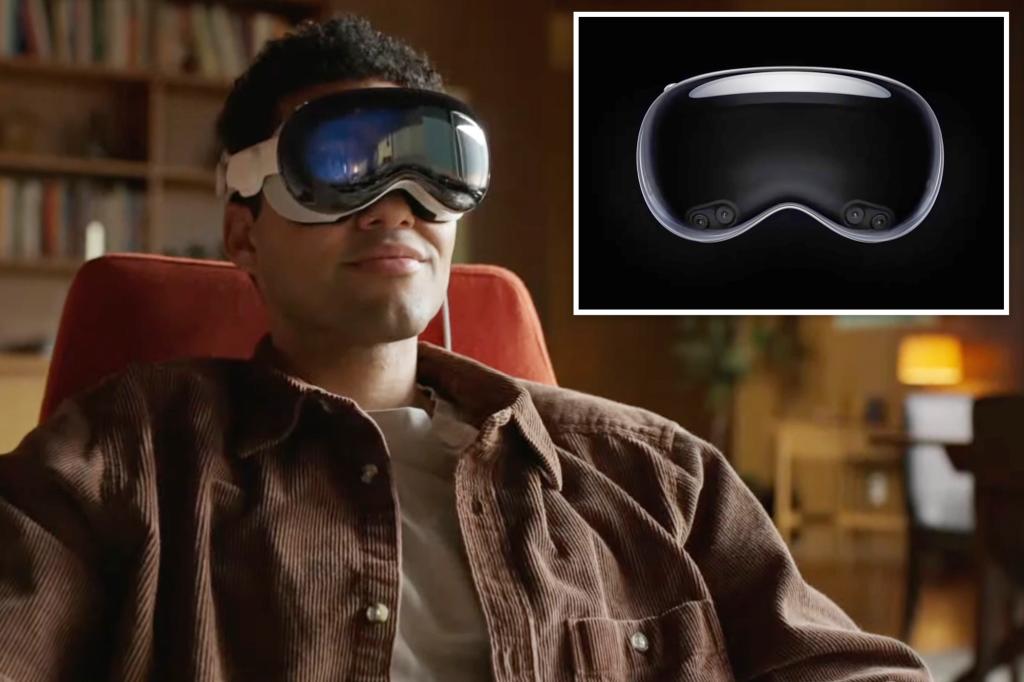Apple on Monday unveiled its long-anticipated mixed-reality headset — with a whopping $3,499 price tag — marking the iPhone maker’s first major product launch in a decade.
Dubbed the “Vision Pro,” Apple CEO Tim Cook debuted the device as the centerpiece of the tech giant’s annual Worldwide Developers conference event at its headquarters in Cupertino, Calif.
“Vision Pro is a new kind of computer that augments reality by seamlessly blending the real world with the digital world,” Cook said during the presentation, describing the device as an innovation on par with the original iPhone or Mac computer.
“It’s the first Apple product you look through and not at.”
The Vision Pro, which resembles a set of high-tech goggles, features a glass screen with 4K resolution displays for each eye on an aluminum alloy frame.
The device has an adjustable headset and stretchable headband. Battery life is limited, with just two hours per use via a pocket-sized external battery pack.
Unlike a computer, Vision Pro won’t require a mouse or keyboard. Instead, users will interact with their virtual displays using voice commands, their eyes and their hands. A small dial included on the headset allows users to adjust how much their apps are visible relative to their real-world surroundings.

Disney CEO Bob Iger made a surprise appearance during the “Vision Pro” presentation, describing the device as a product that would “allow us to bring Disney to our fans in ways that were previously impossible.”
Iger described various ways in which Disney fans could utilize the Vision Pro, including interacting with animated characters, virtually visiting Disney World or watching an NBA game as if you were sitting court-side.
Iger said the Disney+ streaming service will be available on the Vision Pro at launch.

Apple said the Vision Pro will be available for some customers starting “early next year,” meaning they won’t be ready for the upcoming holiday season.
Apple executives talked up a feature called “EyeSight,” which allows users to see their surroundings, such as an approaching person or object, to prevent any awkward or unexpected interactions while using the googles.
Vision Pro has various potential uses, from simple web browsing and text messaging to playing video games to attending business meetings and watching movies in an immersive virtual environment, such as a lakeside forest.
However, some experts were left unconvinced by the “very, very ambitious [$3,500] price point.”
“I just think it’s going to be really challenging,” said Mark Vena, CEO and principal analyst at SmartTech Research.
Vena also pointed out that Apple did not provide concrete details on how much the headset weighs – a potential obstacle for users.
“Until we actually see the reviews and until you get a chance to play with it, it’s hard to make any judgments,” Vena said.

The high-stakes launch followed multiple delays as Apple worked to fine-tune the device.
Apple’s headset is compatible with the company’s pre-existing apps, including Messages, Safari, AppleTV+ and FaceTime, as well as third-party offerings available through the App Store.
The launch was hotly anticipated by investors. Ahead of WWDC, Apple shares hit an all-time high of $184.36, pushing the company’s market cap just shy of $3 trillion.
But the stock pared its gains and turned negative as Apple gave a step-by-step demonstration of the technology — a sign that investors were skeptical of what they saw.
The headset was just one of multiple hardware announcements at WWDC. Apple also revealed an upgraded 15-inch version of its MacBook Air that purportedly “runs completely silent” and has 18 hours of battery life. The computer starts at $1,299 and begins shipping next week.

The event also featured several nods to the current boom in artificial intelligence.
Apple touted the capabilities of a new, more powerful version of its in-house chip, the M2 Ultra, for the training of large language models – the systems used in ChatGPT and other popular chatbots.
The company’s latest Mac Pro computer, which comes equipped with the M2 Ultra chip, starts at $6,999.
The company detailed various updates included in its iOS 17 software, such as real-time transcriptions of live voicemails, a “check-in” feature through its Messages app that lets users tell their loved ones when they arrive home safely, and the ability to leave “voicemails” in the FaceTime app.


Apple’s headset announcement came just days after Meta CEO Mark Zuckerberg posted a surprise reveal of his firm’s upcoming Meta Quest 3 headset on Instagram.
Set for release this fall, the Quest 3 is much cheaper than Apple’s headset – starting at just $499 – and is 40% thinner than its top-selling predecessor, the Quest 2.
Zuckerberg touted the Quest 3 as “the first mainstream headset with high-res color mixed reality.”
Apple’s audacious release is the most significant challenge yet to Facebook parent Meta’s dominance in of the headset market. The competition will play out despite signs of flagging interest in the metaverse.
Sales of VR headsets plunged by 20.9% to 8.8 million in 2022, according to data from research firm IDC. Sales were down by more than half through the first three months of this year.

Meta has a dominant hold over the headset market, with sales of its Quest 2 and Quest Pro products accounting for nearly 80% of the 8.8 million sold, according to IDC.
Even with its sales advantage, Meta has lost billions of dollars on its push into metaverse technology. In April, the company’s latest earnings report revealed a loss of nearly $4 billion in its Reality Labs division, which oversees the metaverse business.
𝗖𝗿𝗲𝗱𝗶𝘁𝘀, 𝗖𝗼𝗽𝘆𝗿𝗶𝗴𝗵𝘁 & 𝗖𝗼𝘂𝗿𝘁𝗲𝘀𝘆: nypost.com
𝗙𝗼𝗿 𝗮𝗻𝘆 𝗰𝗼𝗺𝗽𝗹𝗮𝗶𝗻𝘁𝘀 𝗿𝗲𝗴𝗮𝗿𝗱𝗶𝗻𝗴 𝗗𝗠𝗖𝗔,
𝗣𝗹𝗲𝗮𝘀𝗲 𝘀𝗲𝗻𝗱 𝘂𝘀 𝗮𝗻 𝗲𝗺𝗮𝗶𝗹 𝗮𝘁 dmca@enspirers.com


